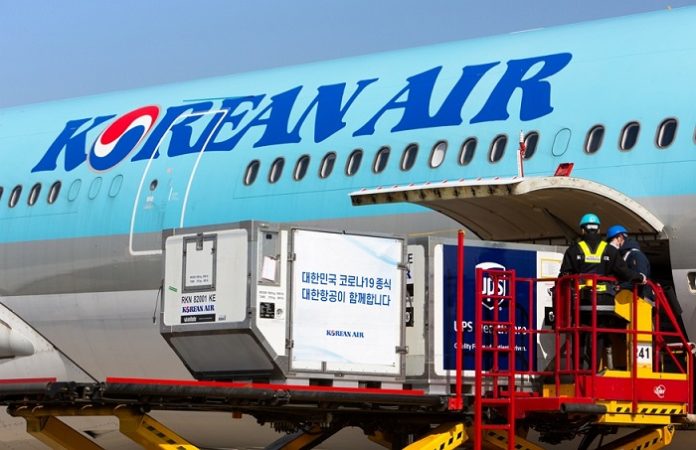
-
Most airlines worldwide continued to see weak air cargo volumes in May 2023 with demand contracting and belly capacity growing as passenger operations rebound
-
IATA data show global demand, measured in cargo ton-km, fell 5.2% y-o-y in May
-
Asia Pacific airlines saw May air cargo volumes fall 3.3% y-o-y as all regions excluding Latin America saw airlines’ cargo volumes contract
Weak air cargo demand continued to drag down air freight markets in May 2023, with global demand slipping from a year ago as belly capacity expanded amid the recovery in passenger business, the International Air Transport Association (IATA) says in a statement on July 5.
Data for May 2023 released by IATA showed global demand, measured in cargo ton-kilometers (CTKs), fell 5.2% year on year with international operations falling 6%.
IATA director general Willie Walsh said the decline in global demand and several other factors show weakness, but he expects some relief this second half.
“Trading conditions for air cargo continue to be challenging with a 5.2% fall in demand and several economic indicators pointing towards weakness. The second half of the year, however, should bring some improvements,” said Willie Walsh, IATA’s director general.
“As inflation moderates in many markets, it is widely expected that central bank rate hikes will taper [off]. This should help stimulate economic activity with a positive impact on demand for air cargo.”
Capacity, as measured by available cargo ton-kilometers (ACTKs) grew 14.5% y-o-y, primarily driven by an expansion in belly capacity as demand in the passenger business recovers. Capacity is now 5.9% above May 2019 pre-pandemic levels, said IATA.
IATA, a group of more than 300 airlines worldwide, said key factors influencing the weak air cargo demand include:
- The global manufacturing Purchasing Managers Index (PMI) indicates an annual contraction of 1.4% in new export orders and a 5.2% y-o-y drop in production PMI. This suggests a cooling in global manufacturing demand.
- Global goods trade fell 0.8% in April due to macroeconomic challenges and supply chain constraints. Trading conditions appeared to favor maritime cargo as demand for container shipping contracted 0.2% while air cargo demand shrank 6.3% y-o-y.
- The global supplier delivery time PMI increased to 54.5 in May, up from its low of 35 in October 2021, indicating shorter delivery times and some relief for supply chains. However, this is also a sign of weaker global goods trade demand.
May regional performance
- Asia-Pacific airlines saw their air cargo volumes contract 3.3% in May 2023 vs. the same month in 2022. This was a 0.3% decrease from April mainly due to the larger 6.4% y-o-y international air cargo demand drop vs. April’s 3.5% fall. Available capacity in the region grew 38.3% y-o-y as more belly capacity came online from the passenger side of the business.
- North American carriers saw the weakest performance of all regions for the third consecutive month with an 8.1% fall in cargo volumes in May 2023 compared with May 2022. This was slight better than April’s 12.4% drop. Airlines in the region saw the third month of two-digit volume slip on the North America-Europe trade lane, down 10.3%. Capacity rose 1.2% y-o-y.
- European carriers saw cargo volumes fall 6.7% y-o-y in May 2023. This was better than in April, when volume fell 7.7% – in part due to the smaller annual drop in international CTKs on the Europe-Middle East trade lane from 4.7% dip in April to a 2.9% easing in May. The drop in international cargo traffic on European markets improved from a 16.2% crash in April to a milder 7.8% fall in May 2023. Capacity increased 5.6% y-o-y in May.
- Middle Eastern carriers experienced a 3.1% y-o-y dip in cargo volumes in May 2023, slightly better than April’s 6.7% decline. Capacity grew 15.6% y-o-y.
- Latin American carriers had the only positive performance in May 2023, with a 3.6% y-o-y increase in cargo volumes. This was a better performance than April’s 1.6% dip. Capacity in May expanded 14.7% y-o-y.
- African airlines saw demand slip 2.4% y-o-y in May 2023, a decline in performance vs. April’s 0.9% easing. Growth on the Africa-Asia trade slowed to 11% in May from 18.5% in April, possibly impacted by Sudan’s conflict since mid-April. Capacity in May grew 9.2% y-o-y.
RELATED READ: Air cargo ends 2022 near pre-Covid level




